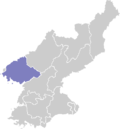Taegwan County
 From Wikipedia - Reading time: 6 min
From Wikipedia - Reading time: 6 min
Taegwan County
대관군 | |
|---|---|
| Korean transcription(s) | |
| • Chosŏn'gŭl | 대관군 |
| • Hancha | 大館郡 |
| • McCune-Reischauer | Taegwan-gun |
| • Revised Romanization | Daegwan-gun |
 | |
| Country | North Korea |
| Province | North P'yŏngan |
| Administrative divisions | 1 ŭp, 1 workers' district, 22 ri |
| Area | |
• Total | 865 km2 (334 sq mi) |
| Population (2008[1]) | |
• Total | 69,565 |
| • Density | 80/km2 (210/sq mi) |
Taegwan County is a kun, or county, in northeastern North P'yŏngan province, North Korea. It lies in the province's interior, and is bounded by Tongch'ang on the east, Kusŏng and T'aech'ŏn to the south, Ch'ŏnma to the west, and Ch'angsŏng and Sakchu to the north. It was created in 1952 from portions of Sakchu county.
Geography
[edit]Taegwan's borders are mountainous, with the Kangnam Mountains rising in the north and the Chonma Mountains in the west. The Taeryong River (대령강) flows through the county's centre, joined in its course by many fast small streams.
Administrative divisions
[edit]Taegwan county is divided into 1 ŭp (town), 1 rodongjagu (workers' district) and 22 ri (villages):
|
|
Climate
[edit]Taegwan enjoys a relatively rainy climate, with an average annual rainfall of 1300 mm. The average temperature is 7 °C, fluctuating between an average of -11.2 °C in January and 22.5 °C in August.
Economy
[edit]Some 83% of the county's area is forested; only 8.5% is cultivated. Most of these are dry fields, with maize the chief crop. Forestry, including lumber as well as the harvesting of wild herbs and fruits, is a major local industry; Taegwan is home to the province's largest lumber base, which specializes in wood for mining and construction applications. Gold and graphite are mined in the county, and a small hydroelectric generator harnesses the Taeryŏng River's stream. It is also home to a ballistic missile factory called No. 301 Factory[2] and an operating missile base to the north of town.[3]
Transportation
[edit]The P'yŏngbuk Line of the Korean State Railway passes through the county, on its way between Chŏngju and Ch'ŏngsu.
Education
[edit]Educational institutions in Taegwan include the Taegwan Technical School.
See also
[edit]References
[edit]- ^ North Korea: Administrative Division
- ^ "No. 301 Factory". Nuclear Threat Initiative. 1 March 2003. Retrieved 28 February 2021.
- ^ Jacob Bogle (23 October 2019). "Missile Bases & Major Underground Sites". AccessDPRK. Retrieved 28 February 2021.
- International Information Research Institute (국제정보연구소) (1999). "대관군". 北韓情報總覽 2000 [Bukhan jeongbo chong-ram 2000]. Seoul: Author. p. 827.
External links
[edit]- In Korean language online encyclopedias:
 KSF
KSF